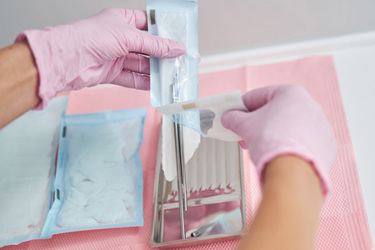Medical Device Packaging Considerations For Product Developers: Begin With The End In Mind
By Peggy Fasano, Boulder iQ

Packaging takes place in the last stages of a medical device’s product development process and is an integral part of a device’s design. By treating it as such, and incorporating packaging early in the process, developers can alleviate stress, minimize risk, create a more effective product, and eliminate cost surprises.
During the entire design process, it is critical to maintain focus on your end goals. The package design affects shipping, sterilization, and the end-user experience. Consider how the package will work once in the field and in actual use. Keep in mind that your goals may extend after the initial market launch, too. They might include obtaining a CE mark or shipping internationally. By planning ahead, packaging materials and design will never hold up your timeline, increase costs, or decrease sales.
Consider a recent implant development program that took years to perfect, with many different configurations of the medical device. The goal was to ensure sterility of the product prior to implantation. The company that had developed the implant came to our company for help with packaging. They had originally designed their packaging as double-pouched, in a carton and terminally sterilized. With that design, the device proved very difficult to remove in the sterile field, even with the double pouch. A user could not just drop the product on a sterile tray. Nor could they easily remove the device from the pouch. With the extra steps required to use the product, suffice to say that surgeons were not pleased with the design. The product was sterile, but almost impossible to use effectively. The company had to go back and redo the packaging design, shipping testing, and shelf-life study – at an ultimate cost of four months in time and tens of thousands of dollars.
Moral of the story: Get clear on your ultimate goals, and design with the end in mind. Here’s where, and how, to do it.
Define Ultimate End Users And Their Needs
As a medical device developer, when you carefully think through, and plan for, how users will implement a device, you design a better, safer, easier-to-use product. When you do so at the beginning of the product development process, we know that the process moves along more smoothly and efficiently. You avoid the need to go back and redesign for problems and issues that arise in later stages, and you are able to zero in on meeting the needs of the market.
Similarly, when you carefully think through, and plan for, how a user will interact with the device in its package, you can focus on true market needs. When you do so at the beginning of the development process, bringing in key stakeholders where needed, you are able to avoid costly design errors and speed things along. Realizing that a fully engineered device does not fit a package that works for the user, or that does not perform as it should with the type of packaging a budget calls for, can spell disaster for medical device developers – and users.
First and foremost, start by defining the end user of your medical device. That may be a combination of people, such as an administrative or receiving agent, a nurse, a doctor, and/or a patient.
Understand The Medical Device In Use
Next, take time to determine how and in what situations each person will use your medical device. Perhaps the receiving clerk will be responsible for storing it at a hospital. You’ll need to know on what size shelves the product will sit, an idea of how many will be stored at any given time, and how easy – or difficult – it will be to see the labeling on the packaging.
When the product gets to the nurse or technician, how will that person unpack the device? What will happen to the packaging in terms of disposal or recycling? Will a physician require double-pouching or aseptic removal of the device from packaging? Should a user be able to drop the product into the sterile field or access the product on a tray? Finally, will the patient have any interaction with the packaging?
Thinking through all these questions during the design process will help create the best experience for customers. The process will yield increased satisfaction and overall adoption rate. The bottom line is that if the product is easy to use for all stakeholders, the more willing they will be to choose your product over others.
Think Now About Shipping, Transportation, And Storage
Packaging should protect your medical device from damage during shipping and transportation. Delving into just how the packaging needs to function may have substantial impact on the design of a device. With some dedicated time, developers can generally incorporate important packaging considerations in the very early stages of the design process.
Important considerations that designers should address include:
- Shipping life cycle: Will the product move through a distribution center and need to meet certain requirements to do so? What will the typical mode of shipping transportation be? How long will it be in route to its final destination?
- International shipping requirements: If the product will ship internationally, will it go by train, airplane, boat, or other? Can the product, the materials in the product, and the packaging survive the temperatures, pressure, and humidity of the cargo bags in which it will move? Is the packaging robust enough for add-on transportation once the product arrives in the destination country? What about customs requirements?
- Volume configurations: Is there a need for custom shipping boxes? How many products will typically ship in a box? Will custom order quantities need to be accommodated? Does the product need to fit into a standard FedEx box?
- Storage considerations: What temperatures and humidity conditions will the product encounter in storage?
- Product protection needs: How sensitive is the product to vibrations, drops, impacts, humidity, temperature, and static changes it may require in shipping? (Reference standards ISTA, ASTM D4169-16, ASTM D4332-14)
- Labeling requirements: Can the label avoid smearing and tearing? Does it address all regulatory requirements? Have you included the unique device identifier?
- Shelf life: Does the product require a shelf life and expiration date? Ideal shelf life will depend on time to market, type of device, and project budget. What is the risk level of the shelf life? The answer to this could affect not only labeling, but the sample size and length of time you test.
By thinking about these up front, during initial packaging design, it’s possible to significantly decrease the risk of a non-compliant medical device – a product that may not pass current or future packaging validations. The ramifications only increase if shipping internationally, which requires more stringent testing than domestic shipping. If a product does not pass that validation the first time with the correct sample sizes, the result is lost time and lost money.
Make Careful Decisions On Packaging Material Cost And Supply
Just as with the building of any product, the availability and costs of packaging materials can play a major role in the overall design and pricing of a medical device. Finding out that a preferred material is backlogged, or has experienced a large price increase, at the end of the design process can mean starting over. Companies on tight timelines, when speed to market is crucial, must avoid this scenario.
In deciding on materials, ask if the end user will be more concerned about the function or the look of the packaging. It could make the decision on material selection clear. What will happen to the packaging once the device has been removed? Will it be disposed of immediately? If no key stakeholder sees or has concern for the packaging, the design team may be able to adjust some packaging elements and allocate overall product development costs accordingly.
Rethink Sterilization
Weighing and ranking all the aspects that go into the packaging for a sterile device can be challenging. But by determining the sterilization method early in the design process, and concurrently working with the packaging and sterilization vendor, you can minimize risk, optimize outcomes, and eliminate cost surprises. You can continue in your process knowing that the ultimate packaging will keep the device sterile while optimizing the space available.
Medical device packaging differs according to the type of sterilization that the product will undergo. For example, ethylene oxide (EO) sterilization requires a breathable packaging material, such as Tyvek, to allow for easy entrance and exit of the EO gas. Gamma and e-beam sterilization methods require slightly different packaging configurations. Steam-sterilized instruments are typically wrapped in a special disposable paper covering with printed stripes that change color when exposed to the steam temperatures.
A keen understanding of these differences can save developers critical time and money. Without doing so, a company that chooses one method of sterilization could find out much later in the process that its device will not work with the selected method, then face redesigning all the packaging to switch to another sterilization method.
No matter the type of sterilization, all pouches or lids need to fully seal the device in the package so no fungus, molds, yeasts, viruses, or bacteria can get to the product through normal handling after sterilization.
The size of the packaging can affect the cost of sterilization – and thereby the entire development budget – significantly. Contract sterilizers deal with set chamber constraints. Therefore, designing the packaging to these constraints can maximize the amount of product that fits into each sterilization run and reduce sterilization cost per product. For example, even 2 inches of extra space in the chamber means unused space that adds up in cost. This is an especially important consideration when working with smaller chambers, since the amount of product that can fit into the chamber can change dramatically depending on package dimensions.
Working with the sterilization vendor up front can help developers design packaging with space utilization in mind. If packaging can be smaller, the more product can fit in the sterilization chamber. Result: reduced sterilization cost per device.
Conclusion
Beginning with the end in mind can be a simple, straightforward way to save time and money. By viewing packaging as part of the medical device, instead of an afterthought, you can get your device to market faster and less expensively. Incorporating packaging design into product design will save valuable resources and help assure market acceptance and use.
About the Author:
 Peggy Fasano is chief operating officer at Boulder iQ. She is an expert in product development, project management, and engineering within the medical device and biotech industries. She has held the positions of senior consultant with Deloitte Consulting, managing director of the Deming Center Venture Fund, product development and engineer consultant for Boulder BioMed, and project manager and mechanical engineer for Sophono, Inc. She also has worked as a mechanical engineer and project manager at Polestar Technologies. Fasano holds a B.S. in mechanical engineering from Tufts University and an M.B.A. from the University of Colorado. She can be reached at peggy.fasano@boulderiq.com or on LinkedIn.
Peggy Fasano is chief operating officer at Boulder iQ. She is an expert in product development, project management, and engineering within the medical device and biotech industries. She has held the positions of senior consultant with Deloitte Consulting, managing director of the Deming Center Venture Fund, product development and engineer consultant for Boulder BioMed, and project manager and mechanical engineer for Sophono, Inc. She also has worked as a mechanical engineer and project manager at Polestar Technologies. Fasano holds a B.S. in mechanical engineering from Tufts University and an M.B.A. from the University of Colorado. She can be reached at peggy.fasano@boulderiq.com or on LinkedIn.
